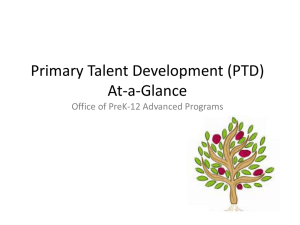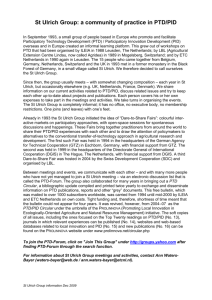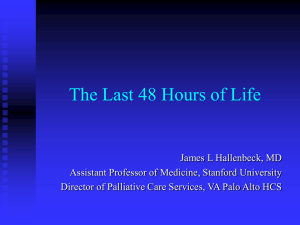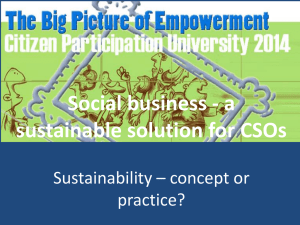How to facilitate design & evaluation farmer experimental workshop:
advertisement
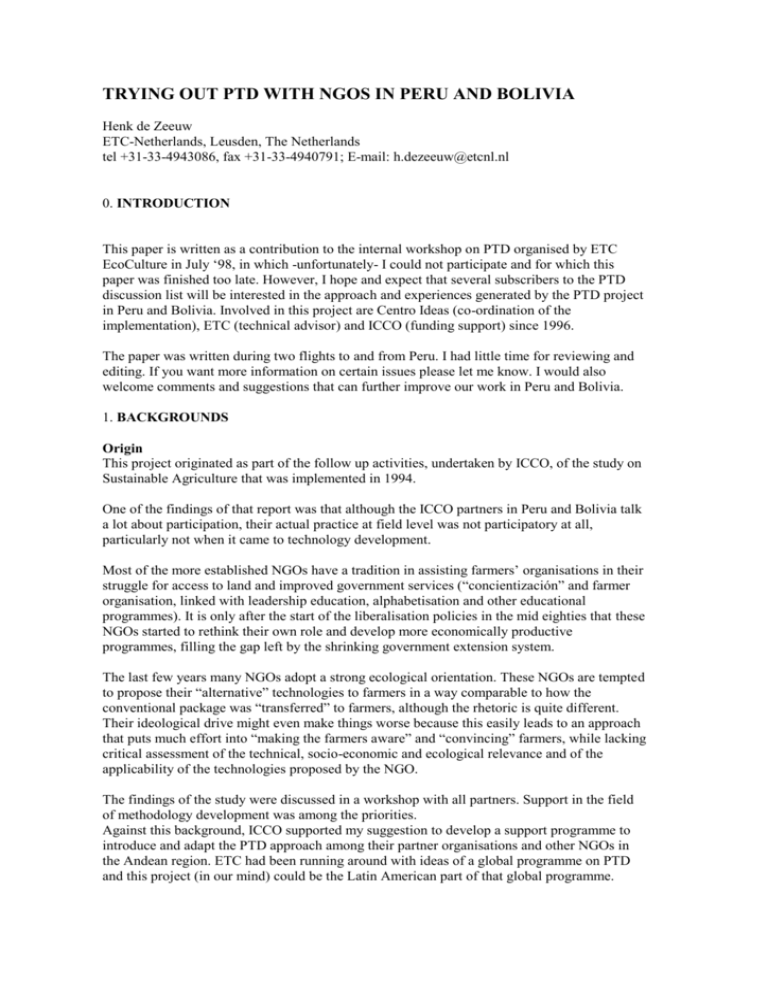
TRYING OUT PTD WITH NGOS IN PERU AND BOLIVIA Henk de Zeeuw ETC-Netherlands, Leusden, The Netherlands tel +31-33-4943086, fax +31-33-4940791; E-mail: h.dezeeuw@etcnl.nl 0. INTRODUCTION This paper is written as a contribution to the internal workshop on PTD organised by ETC EcoCulture in July ‘98, in which -unfortunately- I could not participate and for which this paper was finished too late. However, I hope and expect that several subscribers to the PTD discussion list will be interested in the approach and experiences generated by the PTD project in Peru and Bolivia. Involved in this project are Centro Ideas (co-ordination of the implementation), ETC (technical advisor) and ICCO (funding support) since 1996. The paper was written during two flights to and from Peru. I had little time for reviewing and editing. If you want more information on certain issues please let me know. I would also welcome comments and suggestions that can further improve our work in Peru and Bolivia. 1. BACKGROUNDS Origin This project originated as part of the follow up activities, undertaken by ICCO, of the study on Sustainable Agriculture that was implemented in 1994. One of the findings of that report was that although the ICCO partners in Peru and Bolivia talk a lot about participation, their actual practice at field level was not participatory at all, particularly not when it came to technology development. Most of the more established NGOs have a tradition in assisting farmers’ organisations in their struggle for access to land and improved government services (“concientización” and farmer organisation, linked with leadership education, alphabetisation and other educational programmes). It is only after the start of the liberalisation policies in the mid eighties that these NGOs started to rethink their own role and develop more economically productive programmes, filling the gap left by the shrinking government extension system. The last few years many NGOs adopt a strong ecological orientation. These NGOs are tempted to propose their “alternative” technologies to farmers in a way comparable to how the conventional package was “transferred” to farmers, although the rhetoric is quite different. Their ideological drive might even make things worse because this easily leads to an approach that puts much effort into “making the farmers aware” and “convincing” farmers, while lacking critical assessment of the technical, socio-economic and ecological relevance and of the applicability of the technologies proposed by the NGO. The findings of the study were discussed in a workshop with all partners. Support in the field of methodology development was among the priorities. Against this background, ICCO supported my suggestion to develop a support programme to introduce and adapt the PTD approach among their partner organisations and other NGOs in the Andean region. ETC had been running around with ideas of a global programme on PTD and this project (in our mind) could be the Latin American part of that global programme. Project preparation process a. Selection of co-ordinating organisation I visited some organisations that ICCO regarded as potential co-ordinators of such a programme, to discuss this initiative and to sound their interest. Finally, Centro Ideas was requested to take the lead in the preparation and implementation of this programme with the assistance of ETC-NL. Centro Ideas has a focus on ecological agriculture, is the leading agency in the Agro-ecological Network of Peru (RAE) and had just implemented a project to systematise NGO experiences with ecological projects, which demonstrated their capacity to co-ordinate such a project. b. Project profile I wrote a first set-up of the project profile. This was then discussed with some staff members of Centro Ideas. c. Selection of participating organisations A senior staff member of Centro Ideas visited a large number of NGOs in Peru and Bolivia. In drawing up the list we took into account the following criteria: organisations with proven sustainability, with a focus on sustainable agriculture and participatory approaches, having the capacity to apply and document a PTD process. Preconditions were: (1) employ at least 1 agronomist, (2) have linkages with university and/or research institutes, (3) have an institutional commitment. Sixteen organisations were selected: 8 from Peru, 8 from Bolivia. In Bolivia the first year: SEMTA, La Paz IICCA, Tarija CICDA/PRADEM, Sucre CENDA, Cochabamba In Peru the first year: Centro IDEAS, Piura CEDAP, Ayacucho ARARIWA, Cusco CIED, Puno the second year: KURMI, La Paz ACLO, Potosí QHANA, La Paz CEPAC, Santa Cruz the second year: CICAP, Chiclayo IDMA, Abancay CICCA, Abancay IMA, Cusco d. Finalising project document and budget; approval by ICCO During the above mentioned visits the project profile was discussed with the potential participating organisations resulting in a number of adaptations in the set-up of the project. Also, a Consultative Committee was installed comprising a representative of Centro Ideas (Alfredo Stecher), one ecologist from Bolivia (Jose Lorini, Instituto de Ecología), an agronomist from Peru (Mario Tapia, CIP-CONDESAN) and myself. The committee meets twice a year and advises Centro Ideas on the development of the project. 2. PROJECT OBJECTIVES The main objective of the project is to experiment with the PTD approach with NGOs in the Andes in order to adapt the methodology to the situation in the Andes and the normal working conditions of NGOs. At that time, most PTD experiences were generated in the context of international research institutes and projects with human and financial resources that are not commonly available in NGOs. The socio-cultural, ecological and economical conditions in the Andes require adaptation of the methodology and the development of “regionalised” staff and farmer training materials. As part of the process, the project seeks to strengthen the capacity of the participating organisations to implement participatory approaches in the development and diffusion of agricultural technologies The results of the process will be shared with other organisations (private and public) that support sustainable agricultural development, both during and at the end of the project. Concrete expected outputs of the project are: a. A staff training manual, including instruments for documentation, monitoring and evaluation of PTD experiments, guidelines for facilitating participatory diagnosis, design of the experiments, implementation, evaluation and diffusion; b. Illustrated materials for farmer training; c. 2 videos on PTD process and results; d. 32 technicians and 32 thesis students in 16 NGOs trained in the PTD approach; e. 8 organisations having implemented and documented at least 3 experiments each; 8 organisations having implemented at least 2 experiments each (40 experiments in total). 3. PROCESS OF PROJECT IMPLEMENTATION a. Team formation and basic training The project team consists of three half time persons: project co-ordinator (Julio Chavez Achong, a sociologist) and two team members who co-ordinate and facilitate the activities in Peru (Sandro Chavez) and Bolivia (Rodrigo Villavicencio). Although the original idea was to have at least one woman in the team, three males were appointed in the end. A female staff member of Centro Ideas assisted the team in gender issues (on a consultancy contract). The Peruvian team member is an agronomist with a background in agro-ecology. The Bolivian team member is an agronomist with experience in the PRA approach and participatory project planning. I met with the newly appointed team in Peru and we discussed the various conceptual, methodological and operational aspects of the project. The team members then started preparations for the first activities to be implemented. Shortly after, they participated in a training course organised by CIAT in Ecuador on what they call the CIAL methodology (having many similarities to the PTD approach) During the next team meeting we discussed the experiences gained during this course as a way to specify the approach followed in this project. b. Meeting with NGO directors A workshop with the directors of all participating NGOs was organised. We were of the opinion that a strong commitment of the top of the NGOs would be vital for the success of the project. Training of staff and some isolated experiments would not make much impact on the NGO if the directors and programme co-ordinators of the NGOs were not well aware of the experiments going on. Proper information would lead to their giving support to the integration of the methodology in the institutional approach and working methodologies. During the meeting we introduced the directors or programme co-ordinators of the first batch of EGOs (during the first year participation was restricted to EGOs) to the main PTD concepts and discussed the pre-requisites for a successful application of the PTD approach. At the start of the next year the meeting was repeated involving the directors of the first and second batch of NGOs (during the second year 8 other NGOs entered the project). These meetings proved to be of vital importance for the enhancement of “ownership” of the project among participating organisations and for their commitment to the project. In order to prevent NGOs entering the project only or mainly to get access to funding, the budget of the PTD project was based on the assumption that the costs of the facilitation and implementation of the local experiments would be carried by the participating EGOs themselves. The project only covers costs related to the training and coaching of staff and costs related to the production and distribution of training materials. This arrangement may sometimes complicate the implementation of the local PTD process in the beginning, for instance in those cases where the PTD activities were not yet integrated in the operational plan of the NGO concerned. Staff involved then complains that they have to do a lot more work and lack the proper means to do it. However, it prevents the responsibility for the local activities being transferred to the project and puts pressure on the NGO to fully integrate the PTD process in the institutional approach and planning mechanism. c. Start up workshop Each NGO sent 1 technician and 1 thesis student to the workshop. During this first workshop we developed the following activities: * Introduction to the backgrounds, rationale and main characteristics of PTD as compared to both formal on-station research and ongoing farmer experimentation; * Participants presented and discussed their own experiences with participatory methods of technology development and diffusion; * Review of main concepts involved * Discussion on the role of the NGO/technicians in the PTD process; identification of required skills and attitudes for PTD facilitator * Strengthening of basic skills (horizontal communication, listening, asking questions, observation, systematic field notes, etc.) * Review of the PTD process; self identification of main elements of each step or cluster of activities in the process * Preparation in groups of field exercises with the first steps in the process: preparations, entrance in the community, participatory diagnosis of community resources and farming systems, prioritisation of themes for experimentation (key problem or potential), focused diagnosis of the priority problem or potential, collection of information regarding technologies to try and evaluation of these options, design of the experiments) * Implementation of field exercises in a community selected by one of the NGOs with commitment for follow-up and continuity (in reality, the practical exercise did not go beyond diagnosis and establishment of the main research priority) * Review of field experiences and preparation of the back home activities The materials prepared for and enriched during this workshop were used to develop a first and partial draft of the staff-training guide. d. Field work period In this period (some 8 weeks) the participants initiated the PTD process in their own working situation. During this period, one of the co-ordinators visited the participating staff and farmers on the site to familiarise with the local conditions and participating farmers, and to assist the technicians to overcome certain problems they encountered and enforce the learning process (coaching). e. Second workshop During this second workshop we developed the following activities: a. Review of the experiences gained with facilitating the first steps of the process: - First we looked into the participatory process and the roles of the various actors; - Thereafter, each of the participating organisations presented the draft design of the experiment they planned with the farmers: rationale, objective, participants, experimental variables and treatment levels, layout and statistical design, organisation and management of the experiment, criteria for the monitoring and methods of registration and monitoring); the discussions resulted in suggestions for improvement of the individual experiments as well as identification of flaws in the diagnosis and design process; - This was followed by detailed discussion about the next steps or activity clusters: implementation and monitoring of the experiments, evaluation of results, diffusion of results, planning of the next cycle of experimentation and related working methods and tools.; - Finally we discussed the proper documentation and reporting of the experiences. This included the formulation of the main hypothesis of the project and identification of criteria and indicators of verification (which will be discussed below). The materials developed before and during the workshop were used to develop the manual further. f. Implementation of the experiments During the implementation period, all NGOs were visited at least once by one of the coordinators. Both farmers and the NGO (thesis student) maintained certain records. Photo and video registration of the PTD process and the experiments was encouraged. g. Evaluation workshop During this workshop, each NGO presented the experiences gained during the implementation process and the results of the experiment, making use of a list of performance criteria and indicators. On the basis of the 2 field reports that had been forwarded by the participating NGOs to the coordinators, the latter had prepared a synthesis of the main experiences and some recommendations for improvement. These were discussed in the workshop leading to amendments in the methodology to be applied in the second year. In this workshop we also discussed in more detail questions that had to do with the diffusion of results and the institutionalisation of the PTD process at local and regional level. Results of the workshop were used to further develop the draft PTD manual. h. Second year During the second year the above-described process was repeated (now with 16 organisations) and the coaching activities were continued. The activities related to the systematisation of the experiences gained will get more attention of the project staff in the second year. Also, the diffusion of the experiences gained will get more attention. This is to be achieved by: (1) production of a newsletter (named “DPTeando” literally translated: “PTD-ing”); (2) organisation of a forum in which selected farmer experimenters and NGO staff will present their experiences to interested organisations; (3) introductory lectures at universities for students and university staff; (4) the production of videos on the PTD process; and (5) writing articles and case studies. i. Third year Next year, the process will be continued as in year 2, but more attention will be required for questions related to sustaining the process at local and regional levels: exchange between experimenter groups and the establishment of local networks of experimenter groups, strengthening the linkages with local universities and research centres, and creation of appropriate funding mechanisms for local experimentation. 4. METHODOLOGY APPLIED AT FIELD LEVEL Before presenting some project experiences and results, I will quickly review the methodology as applied at present. a. Initial meeting to establish mutual commitments First meeting with community authorities and leaders (the latter include women farmers, leading women groups, school kitchens, and other organisational forms involving women). Community meeting: presentation of video; explanation of aims and process of the proposed activity; clarifying commitments of both parties; setting date and time for the diagnosis. After the communal meeting an additional discussion is held with the women farmers in order to increase their participation b. Global diagnosis In order to reduce complexity (and gain time in the training process) we selected a number of techniques that -in combination- should provide a balanced view of the local situation. One group of male farmers and one group of female farmers are asked to produce a map of the community resources. The facilitator will guide discussions on the changes that have taken place in the last decade, the way the community is managing the various resources and on specific problems encountered in relation to each of them (forest areas, grazing areas, different types of crop land, water sources, etc.). Later on, the same two groups will define the transect they want to walk in order to observe each of the zones and production systems identified in more detail: type of soil, vegetation, fauna, availability of water, land use, farming practices, specific problems and potentials of this zone. A mixed group of male and female farmers is asked to make a drawing of the organisational resources of the community (both internal and external) and to discuss the role and relative importance of each of them (Venn diagram). With the same, or another, mixed group, technical calendars will be produced for the 3 - 4 main areas of activity (1 or 2 main crops, certain type of animals, important forestry or fisheries or handicrafts or other activity) that give indications both for seasonality and gender division of labour. Finally, the socio-economic stratification of the community is defined (wealth ranking), with 2 or 3 (male and female) key informants. c. Communal meeting In this meeting, the groups present the results of their work starting with the c,d,e groups above (the results of these groups will mainly be used to orient later discussions on “who should be involved” and as an input in the focused diagnosis of the selected problem and the design of the experiment). The presentations by the male and female group result in a male and female perspective on the available community resources and the main problems encountered in the use and management of these resources. With help of a simple procedure (distribution of seeds) the integrated list of problems are prioritised and one or two main problems are selected (in case the community decides to select both, the first priority identified by the male farmers and the first priority of the female farmers). Subsequently, the next steps in the procedure are explained and it is discussed who should participate in the detailed analysis of the problem (taking into account the existing division of labour and socio-economic stratification). d. Focused diagnosis 1. Self study by technician Before entering this stage, the technician of the NGO needs to improve his/her own knowledge of the problem prioritised by the community, through literature, discussions in the team, and contacts with specialists in the university and other organisations. 2. Farm visits Subsequently, the technician will visit one or two farm households in each of the strata that were identified in the global analysis (preferably households that will participate in the focused diagnosis). During this visit, the facilitators will: develop –together with the family members- a farm diagram, indicating the resources at the disposal of this family, the main areas of activity and the linkages between these areas (flows of energy/materials) and the related division of labour; discuss with the family how the selected problem presents itself on this farm (when, where, under what conditions, and how the problem effects the other components of their production system); exchange information on the solutions that the family has been trying out for themselves, how, with what kind of results, and other experiments they have been implementing recently and why/how. c. Diagnosis workshop With the farmers (m/f) that have shown special interest in the subject and/or have special knowledge and experience in the theme, a meeting is organised to analyse the selected problem in more detail: how does the problem presents itself (where, when, conditions ), making use of the community maps, transects and farm diagrams; analysis of causes (problem tree). Subsequently, the group will: define which of the causes they want to address first and why (plus linkages between solving this aspect and the other causes of the problem); make a first inventory of eventual solutions for this specific problem. d. Searching for “things to try” Before entering the design workshop, both farmers and the facilitating technician will seek additional information about possible solutions for the selected specific problem. Some NGOs organise visits to other villages or projects, or invite “experts” from other villages and/or information centres in order to share their knowledge with them. Also the NGO worker should continue to deepen his/her knowledge about this problem and possible solutions. e. Design workshop (may be spread over various meetings of short duration) In this workshop the farmers and facilitators develop the following activities: Analysis of the advantages and disadvantages of each of the technical options identified Selection of the option(s) they want to try Definition of the aim(s) of the experiment and what results are expected (by the farmers, by the technician) Definition of the experimental variable(s) and levels of application Definition of the conditions the farmers have to maintain more or less equal during installation and management of the experiment (e.g. soil fertility, sowing date, sowing density, etc.) Design of the lay-out and location of the experiment Programming of activities to be undertaken, including acquisition of inputs needed Definition of the way the group will monitor the development of the experiment (what, when, how to observe, measure, register; individual and group wise) Auto-selection of the experimenters and group formation f. Implementation and monitoring Most groups of experimenting farmers consist of six to ten male and female farmers (with the men being in the majority). In two cases, the farmers decided to experiment as a group in a central field made available by the community or by one of the group members. Groups meet regularly, with and without the presence of the NGO technician or thesis student, to discuss how to handle unforeseen factors (e.g. “do we spray against this attack or not”) and visit each others' field to make observations and measurements at crucial moments in the development of the crop or animal. Each experimenter maintains an individual record in which all activities in the experimental plot are annotated, quantifying amounts of seed and other inputs applied, and annotating observations made. Each group maintains a group record in which they note down all discussions regarding the experiment and decisions taken as well as observations regarding group development (participation, decision making, etc.). The monitoring is not restricted to the experimental plot only. The technicians are encouraged to monitor also what is going on in “spontaneous” additions to the jointly defined experiment and replications of the experiment by other farmers. g. Evaluation workshop Before entering this stage the technician needs to process all information collected, making simple tables and applying statistical tests whenever appropriate. After finalising the experiment the group meets to: discuss the development of each experimental plot and factors that influenced its development (resulting in a matrix of plots against influencing variables); this in order to create a good basis for the correct interpretation of the results review the results of the experiments, looking into each of the criteria defined during the design stage (farmers and technician) as well as other observations made during the experimental process. formulate a final conclusion regarding the results of the experiment discuss for whom the results of the experiment are of interest and how they can be informed about these results. Diffusion activities are programmed discuss, finally, when and where the set up of the next experiment will be discussed. e. Diffusion In some cases, the group organised a community meeting. In other instances, the NGO assisted in organising an exchange between experimenter groups of different villages. Also, recordings were made for broadcasting on the local radio or an easy-to-read farmers’ report of the experiment was printed for distribution to farmers in other villages. 5. EXPERIENCES UNTIL DATE Let me present the experiences the project has gained so far, making use of the main hypothesis of the project: Hypothesis 1: The PTD approach strengthens the farmers’ experimentation by: - providing instruments that facilitate local farmers to jointly engage in systematic experiments in order to generate new agricultural technologies or try out and adapt existing ones in dialogue with external agents - strengthening the local organisation for innovation and the capacity of farmer experimenters to make systematic observations, diagnose problems, identify under-utilised potential and to design, monitor and implement experiments and diffuse its results At present, the project is assisting 24 experimenter groups involving about 300 farm households. The process is still in its initial stages, therefore, we have to see how it develops over time. It is, however, beyond doubt that the PTD process generates a lot of enthusiasm among the participating farmers. Farmer experimenters feel recognised. For many of them it is the first time they experience that the technicians are more than superficially interested in their opinions, knowledge, and their capacity to self-manage the design and monitoring, implementation and evaluation of agricultural experiments and the diffusion of results. The PTD process clearly intensifies the exchange between farmers about their individual efforts to experiment with alternative technologies and management practices or the improvement of existing ones. PTD helps to overcome the isolation in which farmers normally are conducting their experiments. Non-group members regularly replicate the organised PTD experiments. Group members often implement additional experiments on the same issue next to the experiment designed in the group in collaboration with the NGO. Experimenter groups that did not have good results in the first year insisted on continuing for a second year of experimentation. The farmer experimenters often have a very clear idea about what they want to experiment with in the coming season (often a replication of the same experiment under different growing conditions or application of the same principle or practice in another crop). Points that we try to improve are: the selection of farmer experimenters (identification of local experimenters, participation of women, preventing that the interests of families with more status and economic power dominate the PTD process). the process towards consolidation of farmer experimenter groups and development of adequate relations between experimenter groups and the community (local leaders, other existing organisations) and support organisations. It is clear that one year is not sufficient to get to a stage in which the groups can continue the process themselves with a much lower support from the NGO. However, one experimenter group that was left alone by the NGO continued without the assistance of the technician in the second year. Most NGOs are very much focused on their relationship with “their” communities. However, in order to create more self-reliant farmer experimenter groups, NGOs involved in PTD have to stimulate the experimenter groups to establish linkages with all sorts of sources of technological information and support. Also, the linkages between the experimenter groups and other farmer organisations at village and inter-village level need to be developed in order to ensure accountability and diffusion of results. the interaction between technicians and farmers. The first year the technicians too much dominated the process, pushing their definition of the problem, their solutions, their experimental design, their evaluation criteria. In the second year (after reflection) the teams tilted over to the other extreme and showed the tendency to do “what the farmers wanted” restricting themselves to the role of facilitator. In both cases, we end up with deficiencies in the analysis and design. Now the involved technicians realise that we need a good balance between the inputs of the farmers and those of the technicians in all stages of the process (in the diagnosis, in the analysis of causes of the problem, in the identification and evaluation of options to try, in the evaluation of the results) and that the degree of interaction between local knowledge and criteria and the knowledge and criteria of the support organisation explains large part of the success in PTD-processes. Hypothesis 2: The PTD approach leads to the generation or adaptation of technologies that significantly contribute to the development of more productive and sustainable farming systems and improved livelihood of the population Very few experiments failed. Where the experiment failed, participants still value the lessons learned during the process: improved understanding of why/how a certain problem occurs, enhanced knowledge of a range of potential solutions and their advantages and disadvantages, experiments others have been doing, etc. In many cases the farmers evaluate the relevance of the results of the experiments positively. Nevertheless, there is still room for improvement: in some cases the experiment does not relate to issues that are strategic in the development of the local farm systems; in other cases the experimental design is deficient (e.g. insufficient analysis of the available options or the application of irrelevant treatment levels, or one has not taken into account the limited availability of certain resources on which the experiment is based) The first year we had experiments of all sorts. In the second year we see a concentration on improved soil fertility management (50%) and pest and disease management (25%). This thematic focus makes it easier to prevent some of the problems mentioned above and to provide backstopping to the NGO staff regarding technical options tried elsewhere and their potential advantages and disadvantages. Also the number of experiments in livestock management (feeding ratios, management of internal parasites, etc.) are increasing. We further try to improve in this area: During the national workshops and during the field visits made by the co-ordinating team to the various sites technicians and the national co-ordinators jointly analyse the problem situations and proposed solutions in order to enhance the analytical capacity and system thinking By improving the forward planning: most NGOs are still used to thinking in terms of an experiment during one crop season. However, farmers are used to compare between different crop cycles. Farmers want to test the same technology in another crop or under other soil/water/input conditions. Certain changes in the technology applied often create a need for adaptations in other components of the production system. Furthermore, most problems are not solved by trying out one technology and will need complementary measures in order to get fully solved. Hence, farmers urge the NGOs to think at least in terms of a series of experiments with varying but often closely related themes and objectives. Hypothesis 3: The PTD approach helps to improve the relevancy and efficiency of the research and extension efforts of NGOs by supplying concepts, methods and tools that facilitate the incorporation of farmer criteria and knowledge and the creative interaction between farmerexperimenters and other actors involved in the agricultural innovation process The participation in the PTD project has positively influenced the capacity of the NGOs to implement participatory rural development projects. The NGOs have responded much better than initially expected. They participated with their own resources, and only a small contribution of the project (daily allowance for the thesis student). All except one NGO have continued their participation in the project. One organisation never started implementation of the experiments due to an overload of commitments. Various other NGOs requested to be included in the PTD project (which could not be done due to limited human and financial resources). In various NGOs, the introduction of the PTD approach has led to changes in their concept of extension and research, their vision of the role of the technical staff viz. the role of the farmers, and adaptations in the field work methodology. Most of the institutions involved have, at least partly, incorporated the PTD methodology and the instruments. It could be noted that the integration of the concepts and the diagnosis methods are incorporated more quickly than the process of design and implementation of experiments. Initially, several technicians ran into problems for having to implement their tasks in the PTD project next to their “normal” work. However, this year various NGOs have fully integrated the PTD activities in their medium-term and annual operational plans. Several NGOs indicate that PTD is very interesting but time consuming. NGOs have increasing difficulty to attract funds and have a tendency to overload their technical staff with tasks in various projects. In such a context it is difficult to devote sufficient time to the periodic interaction with the farmer experimenters and some institutions left a large part of the work to the thesis students, or even used these students for various other activities. This poses a threat to the continuity of the PTD process (although in various occasions the “thesistas” were contracted after having finalised their thesis). This made us think of the relation between the PTD methodology and other methodology development activities undertaken by the EGOs. I have the impression that the PTD approach will be easier to accept and incorporate into the NGOs if it is part of a broader project and methodology, e.g. by using the results of the global diagnosis not only to define the research agenda and to enter the PTD process, but also as a basis for the planning of a project or the development of a community resource management plan. The experimenter group becomes part of a broader process in the whole community justifying a certain amount of time input by the NGO that is difficult to justify for the PTD activities alone. The participation of the thesis students has had mixed results: On the one hand they contributed a lot to the documentation of the process and the generation of discussions regarding research methodology in the universities. The latter generated various requests for participation in workshops and training courses for staff and students of universities and fierce debates on the criteria that are applied to evaluate the thesis. The first four theses have been accepted by the universities, which is generally seen as a major (but unintended) achievement of the project On the other hand we have seen, during the first year, that the interests of the thesis student (and the criteria applied by the university e.g. regarding the statistical design of the experiments) tended to dominate the PTD process. This was corrected in the second year by requiring a leading role of the NGO worker and the use of "practicants" rather than thesis students. Hypothesis 4: The PTD approach facilitates the diffusion of agro-ecological and gender approaches among NGOs and farmer communities by stimulating processes and criteria that facilitate enhanced understanding of the importance and principles of good management of local natural resources and revaluation of the role and knowledge of women. This is probably the hypothesis we have been wrestling with most: how to effectively integrate gender in the methodology and training courses; how to ensure a system approach and holistic problem solving? Most of the NGOs participating in the project have diffuse ecological notions and technologies. However, some of them showed the tendency to replace the conventional “package” for an “ecological” package of recommended practices, without proper analysis of the fit between the recommended practices and the local needs and production conditions and systems. The PTD approach has helped a lot to correct this bias. Even so, we observe that many technicians are still lacking skills and knowledge that would allow a more profound analysis of the interrelations between the various components of production systems, between the various causes of key problems, of the advantages and disadvantages of certain solutions, etc. The PTD process (in its present form leads) too easily to experimentation with single technologies to solve “single” causes of priority problems. But how to counteract multiple causes for the same problem? However, it is clear that the PTD methodology favours the ecological approach by helping the technician to develop a genuine interest in the local farming systems, develop insight in available local knowledge and the criteria the farmers apply in managing their resources. In the field of gender we could observe that the PTD approach is favouring the diffusion and application of gender concepts once the right method for introducing the approach is chosen. During the first year of the project gender issues were dealt with by a gender specialist (a parttime consultant to the project) who applied an approach focusing on pointing out the suppression of rural women and the need for empowerment, which did not meet with much acceptance in the rest of the co-ordinating team and did not integrate into the available methodology and instruments. Before the start of the second year, we organised an internal workshop to overcome this problem with the help of another external consultant. This person gave much more emphasis to gender analysis and planning as part of system diagnosis and the design of the experiments and how proper understanding of the division of labour and the differential task, knowledge and interests positively influence the quality of the design of the experiments and the sustainability of its results. The team interiorised this approach, and appropriate instruments were included in the methodology and training. The evaluation of the second year indicated that progress is made. We try to further improve, among others by preparing “pedagogical cases” on the basis of practical situations taken from the experiences gained in the first two years. These cases are discussed during training sessions (participants have to come up with their own recommendations regarding how to go about a certain situation).
